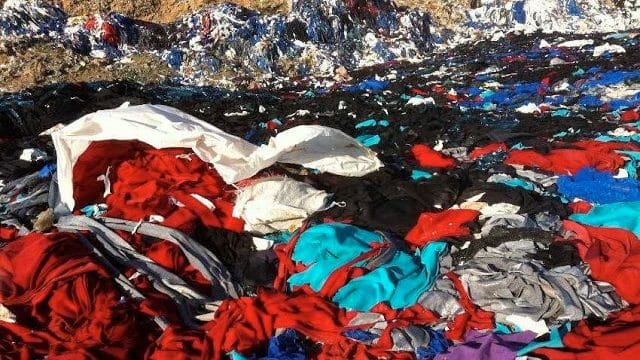Australians throw away over 80% of their textiles each year – we are second highest wasters in the world! I find figure is disturbing – do you too? Most of these fabrics are synthetic and as you know, in landfill these take ages to break down.
 |
| image source: www.onegreenplanet.org |
Did you know, even more disturbingly, that when we wash our synthetic clothes they are contaminating the oceans too – poisoning all types of sea creatures and coming back as toxic food? Microfibres from degrading synthetics, a type of micro-plastic, are a major global problem. Thousands of fibres come off every time we wash – polar fleeces are one of the worst. The chemicals from these microfibres have been found in the flesh of fish (not just the gut). One quarter of all fish contain micro-plastics and micro-fibres.
According to Dr Mark Brown of UNSW, 85% of plastics in the environment are micro-plastics and these are persistent, cumulative and toxic. Dr Brown has studied fish on 6 continents and found that micro-fibres from synthetic clothing are the main micro-plastics in fish. So what does this mean? For one, micro-fibres contain flame retardants which are endocrine disruptors affecting our hormonal systems and altering our immune responses. Read more in the ABC Catalyst story : http://www.abc.net.au/catalyst/stories/4424996.htm .
There are billions of people wearing and washing plastic clothing every day. This micro-fibre problem is immense – more diabolical than micro-beads.
Let’s stop and ask “What impact do the clothes I am wearing and the sheets I am sleeping on have on my my health, my family’s health, on the health of Earth’s ecological systems, as well as the well-being of the people that made them?”
The long and short of this:
- Synthetic fibres shed and accumulate as toxicity in nature.
- Natural fibres biodegrade and are recycled by nature. (Most of my old clothes end up as mulch, worm food and compost)
Those of you who have read my blog posts before know I focus on food and growing, but today I am moved to write from a different angle. Thanks to the many recent conversations I’ve had with people on this disastrous link between fast fashion, ecological systems disruption and toxicity in our food.
Please join me in thinking about this big issue and next time you are heading out to make a textile purchase. And please me spread the word by sharing this post with your friends and networks.
Think, buy, use, renew and make natural!
 |
| Might be time to get those alpacas ….
image source: www.goodonyou.org.au |



That's a sobering post, Morag. In another way though, it's a post which makes us think about another area of our everyday lives where we can make choices that make a difference. Over the last few years, I have saved up to buy bedding sets made from organic cotton when they have come on sale from ethical shop I like to support (If we don't support these kinds of enterprises, they disappear and then we have fewer choices, in my opinion). We have one set each and one pillow each. The sheets have been washed many times now. They are so soft and they keep on getting softer the more they are washed! They will last for years and I will be patching them when they wear thin in places. As far as clothing goes, I decided I wanted to learn to sew this year and I have been making a few of my own clothes though, now that I am no longer working everyday, I find that I don't need as many things. Thanks for such thoughtful posts, I really enjoy reading them. Meg:)
The way we consume, clothing and even house hold appliances and furnishings these days is such an important issue.
Everything is fast, cheap, it's frightening.
A great little article. I knew microfibres were found in the fish's gut but not in their flesh. Things like this motivate me to keep trying to simplify and working to live more gently in this earth.
Xx
Oh my goodness, I didn't know about microfibres polluting our water ways! Where have I been? I am not a fashionista by any standards and buy second hand mostly, looking for easy care garments that don't require ironing – hello microfibres..I feel quite ashamed. Thankyou you Morag for highlighting this disturbing fact. When you know better you do better! I knew about the microbead disaster but not about what simple washing of synthetic clothing does.
Fi
Hi Fiona, I like your comment "When you know better, you do better!" I'm sorry for making you feel bad – I wasn't trying to make anyone feel guilty. When I find out info like this, I just feel so compelled to share it since I think it's something we'd like to and need to know, so we can make positive changes. 🙂
great mind opening article, i opt for natural fibre clothing, hemp should be the obvious viable solution as it can grow in almost any climate of the earth. But as it is sooooo suppressed its price tends to be very high and also hard to find. None the less we must shift our mind set and look/act on the bigger picture. Thanks for your concern and action
Thanks for this great article. I am giving a talk on conscious living at The Henty Field Days and I will include some of what you mention here. I was already going to discus the problems with "fast Fashion" such as slave labour, dubious resources, over consumption and the problems facing charities with the abundance of donations of second hand clothing etc.
Morag, are you able to quote your source on the statement "Australians throw away over 80% of their textiles each year – we are second highest wasters in the world!".Karen